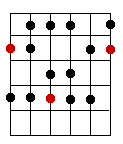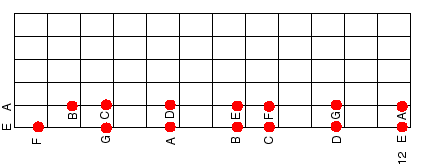 |
SCALES - INTRODUCTION TO the SCALE OF A MAJOR
There are some important keys to becoming a better lead player and improviser. All the knowledge a guitarist learns can be used for a variety of playing styles, not just lead guitarist. The rhythm guitarist can learn to be much more than a mere strummer in the background. There are so many interesting riffs and fills that become an important part of the rhythm.
WHY SCALES?
The understanding of chords and scales are the key to mastering your guitar. Knowing the Major chords is the first step in guitar learning. The scales are what is going to separate you from the other players. Mastering the technique will make you a better player.
Many people get completely freaked out by the notion of scales because there are so many. It is true since there are 12 Major scales and 36 different Minor scales. This can be very overwhelming to new and older players alike. Learning the scales does not have to be so bad. The guitar is designed to make scales simple for the player once they have a grasp at the concept.
Think of scales like you do chords. You can take a chord, shape and turn it into another chord by placing it somewhere else on the fret board. You can do the exact same thing with scales. The Scale of A is one of the key scales to master.
THE A SCALE
A scale is a sequence of notes generated from one specific note to the next occurrence of that same note again. This sequence of notes is a specific pattern using a combination of whole and half steps, depending on which scale you are playing. It is this pattern that determines the scale name.
For the A scale the notes are A, B, C#, D#, F, G#, and A again.

– insert “A – 5th fret” to left of left most red dot and “7th Fret” to left of black dot directly underneath
This is a whole tone scale because each of the 6 notes is one whole step from the other. A is the root note, or starting point. So this is the A whole tone scale. It is very important to know the A scale because it is in most songs played today.

Your reference on where to start is at the root note A. Here is a map of what this would look like on the fret board.
To construct an A Major scale you need to be familiar with the Circle of Fifths. This will help you determine if there are any sharps or flats in the scales you choose to play. As we already know there are three sharps in the A Major scale. If you did not already know that you would want to lie out a diagram to figure it out on your own based on the Circle of Fifths.
The Circle of Fifths has many uses and is valuable tool. The most common use is to help musicians know what type of chords should be used in a song. Each note that is on the circle is a 5th higher than the note before it. Use this chart to help construct what notes you will playing in your a Major scale.

First list the notes in order beginning with A. Do not worry about if they are sharp, flat, or natural yet.
| 1 | 2 | 3 | 4 | 5 | 6 | 7 | 8 |
| A | B | C | D | E | F | G | A |
Next, look at the Circle of Fifths to determine if there are any sharps or flats. You will go through the notes step by step using the formula for making a major scale.
| Formula: | Key: A |
| 1 to 2 A to B is a whole step. No adjustment needed. | B |
| 2 to 3 B to C is only a half step. Note must be sharped. | C# |
| 3 to 4 C# to D is a half step. No adjustment needed. | D |
| 4 to 5 D to E is a whole step. No adjustment needed. | E |
| 5 to 6 E to F is only a half step. Note must be sharped. | F# |
| 6 to 7 F# to G is only a half step. Note must be sharped | G# |
| 7 to 8 G# to A is a half step. No adjustment needed. | A |
The Circle of Fifths confirms that there are 3 sharps in the A major scale as follows:
1 2 3 4 5 6 7 8
A B C# D E F# G# A
Now that you know that the C, F, and G notes in this scale are sharp you would want to note that with a # sign after each one. Practice the A Major scale till you feel comfortable. Once this is accomplished you will be able to tackle songs or improv in this scale and create some great music.
 |  |